Strategic Change Management Report: British Petroleum Analysis
VerifiedAdded on 2019/09/23
|6
|1759
|164
Report
AI Summary
This report delves into the critical need for strategic change management within British Petroleum (BP), addressing the aftermath of the 2010 oil spill and its impact on the company's environmental policies, leadership, and overall market position. It examines the legal, social, and economic challenges BP faces and emphasizes the importance of implementing innovative environmental policies to regain stakeholder trust and competitive advantage. The report highlights the necessity for strategic changes in leadership, particularly in deepwater drilling, and emphasizes the need for enhanced safety measures, ethical business practices, and transparency. It discusses the concept of change management and its significance in achieving organizational goals, emphasizing the need for a structured and well-planned approach aligned with BP's mission and vision. The report utilizes the provided references to support the analysis of the situation and propose the strategic changes that BP needs to implement.
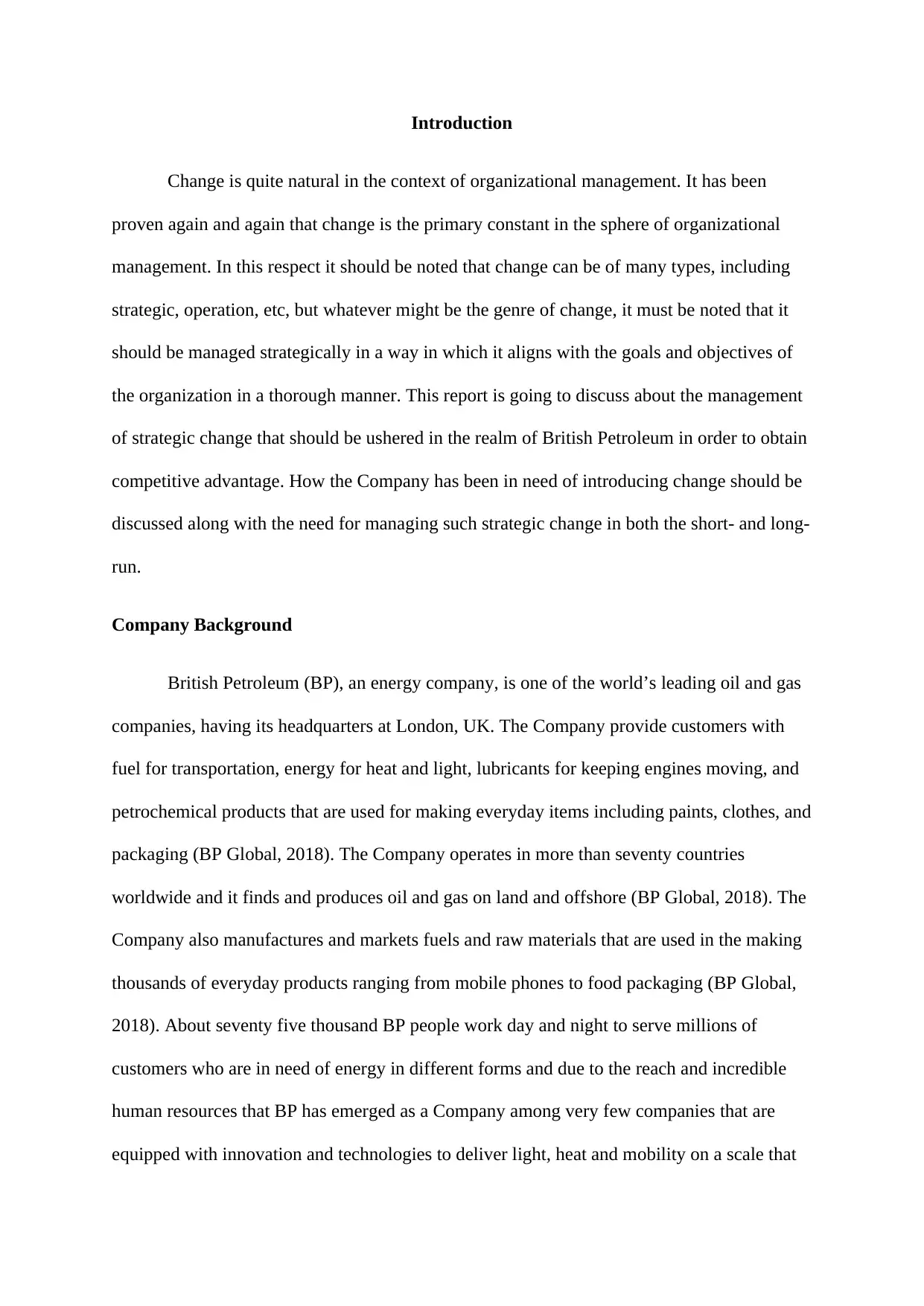
Introduction
Change is quite natural in the context of organizational management. It has been
proven again and again that change is the primary constant in the sphere of organizational
management. In this respect it should be noted that change can be of many types, including
strategic, operation, etc, but whatever might be the genre of change, it must be noted that it
should be managed strategically in a way in which it aligns with the goals and objectives of
the organization in a thorough manner. This report is going to discuss about the management
of strategic change that should be ushered in the realm of British Petroleum in order to obtain
competitive advantage. How the Company has been in need of introducing change should be
discussed along with the need for managing such strategic change in both the short- and long-
run.
Company Background
British Petroleum (BP), an energy company, is one of the world’s leading oil and gas
companies, having its headquarters at London, UK. The Company provide customers with
fuel for transportation, energy for heat and light, lubricants for keeping engines moving, and
petrochemical products that are used for making everyday items including paints, clothes, and
packaging (BP Global, 2018). The Company operates in more than seventy countries
worldwide and it finds and produces oil and gas on land and offshore (BP Global, 2018). The
Company also manufactures and markets fuels and raw materials that are used in the making
thousands of everyday products ranging from mobile phones to food packaging (BP Global,
2018). About seventy five thousand BP people work day and night to serve millions of
customers who are in need of energy in different forms and due to the reach and incredible
human resources that BP has emerged as a Company among very few companies that are
equipped with innovation and technologies to deliver light, heat and mobility on a scale that
Change is quite natural in the context of organizational management. It has been
proven again and again that change is the primary constant in the sphere of organizational
management. In this respect it should be noted that change can be of many types, including
strategic, operation, etc, but whatever might be the genre of change, it must be noted that it
should be managed strategically in a way in which it aligns with the goals and objectives of
the organization in a thorough manner. This report is going to discuss about the management
of strategic change that should be ushered in the realm of British Petroleum in order to obtain
competitive advantage. How the Company has been in need of introducing change should be
discussed along with the need for managing such strategic change in both the short- and long-
run.
Company Background
British Petroleum (BP), an energy company, is one of the world’s leading oil and gas
companies, having its headquarters at London, UK. The Company provide customers with
fuel for transportation, energy for heat and light, lubricants for keeping engines moving, and
petrochemical products that are used for making everyday items including paints, clothes, and
packaging (BP Global, 2018). The Company operates in more than seventy countries
worldwide and it finds and produces oil and gas on land and offshore (BP Global, 2018). The
Company also manufactures and markets fuels and raw materials that are used in the making
thousands of everyday products ranging from mobile phones to food packaging (BP Global,
2018). About seventy five thousand BP people work day and night to serve millions of
customers who are in need of energy in different forms and due to the reach and incredible
human resources that BP has emerged as a Company among very few companies that are
equipped with innovation and technologies to deliver light, heat and mobility on a scale that
Paraphrase This Document
Need a fresh take? Get an instant paraphrase of this document with our AI Paraphraser
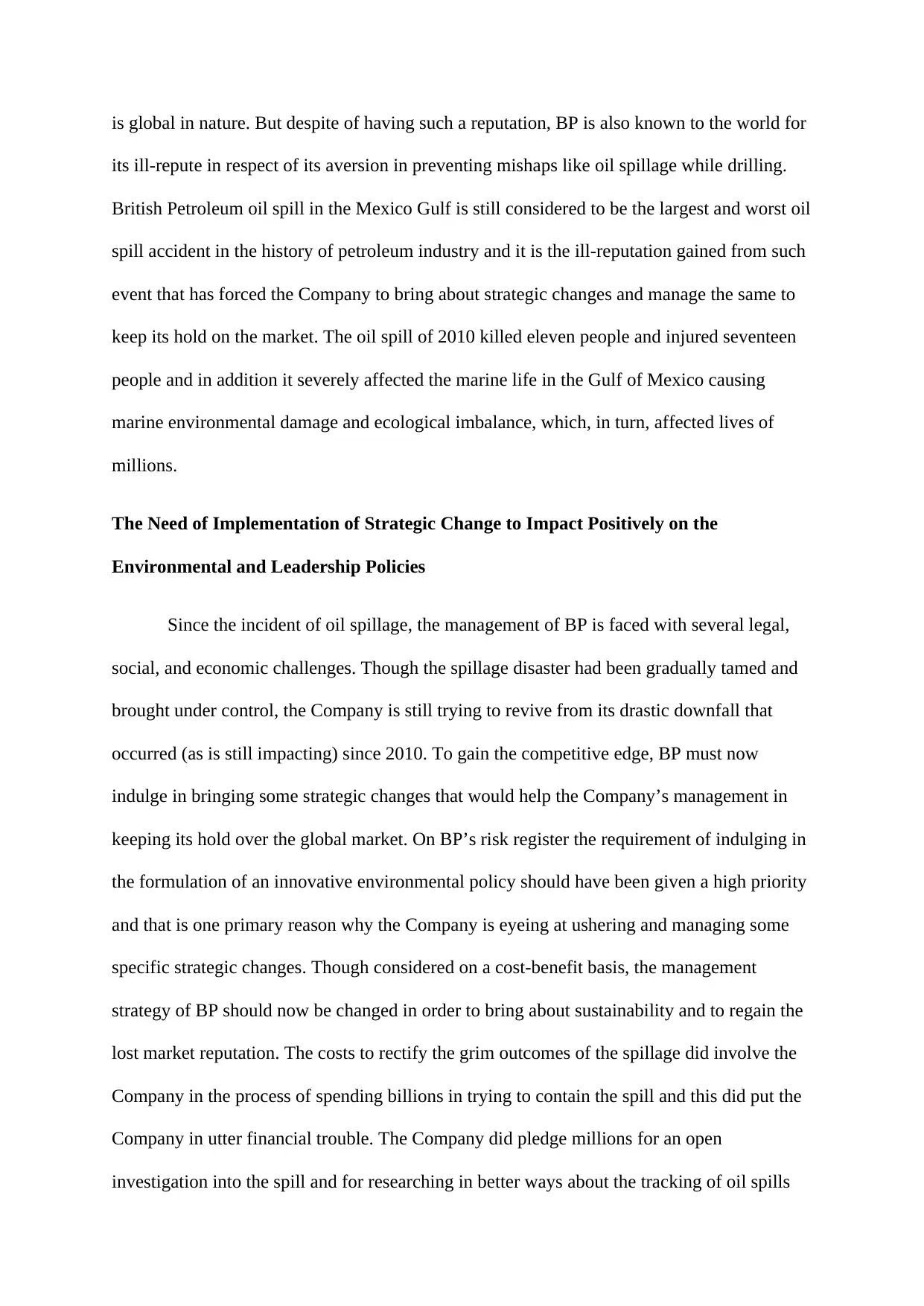
is global in nature. But despite of having such a reputation, BP is also known to the world for
its ill-repute in respect of its aversion in preventing mishaps like oil spillage while drilling.
British Petroleum oil spill in the Mexico Gulf is still considered to be the largest and worst oil
spill accident in the history of petroleum industry and it is the ill-reputation gained from such
event that has forced the Company to bring about strategic changes and manage the same to
keep its hold on the market. The oil spill of 2010 killed eleven people and injured seventeen
people and in addition it severely affected the marine life in the Gulf of Mexico causing
marine environmental damage and ecological imbalance, which, in turn, affected lives of
millions.
The Need of Implementation of Strategic Change to Impact Positively on the
Environmental and Leadership Policies
Since the incident of oil spillage, the management of BP is faced with several legal,
social, and economic challenges. Though the spillage disaster had been gradually tamed and
brought under control, the Company is still trying to revive from its drastic downfall that
occurred (as is still impacting) since 2010. To gain the competitive edge, BP must now
indulge in bringing some strategic changes that would help the Company’s management in
keeping its hold over the global market. On BP’s risk register the requirement of indulging in
the formulation of an innovative environmental policy should have been given a high priority
and that is one primary reason why the Company is eyeing at ushering and managing some
specific strategic changes. Though considered on a cost-benefit basis, the management
strategy of BP should now be changed in order to bring about sustainability and to regain the
lost market reputation. The costs to rectify the grim outcomes of the spillage did involve the
Company in the process of spending billions in trying to contain the spill and this did put the
Company in utter financial trouble. The Company did pledge millions for an open
investigation into the spill and for researching in better ways about the tracking of oil spills
its ill-repute in respect of its aversion in preventing mishaps like oil spillage while drilling.
British Petroleum oil spill in the Mexico Gulf is still considered to be the largest and worst oil
spill accident in the history of petroleum industry and it is the ill-reputation gained from such
event that has forced the Company to bring about strategic changes and manage the same to
keep its hold on the market. The oil spill of 2010 killed eleven people and injured seventeen
people and in addition it severely affected the marine life in the Gulf of Mexico causing
marine environmental damage and ecological imbalance, which, in turn, affected lives of
millions.
The Need of Implementation of Strategic Change to Impact Positively on the
Environmental and Leadership Policies
Since the incident of oil spillage, the management of BP is faced with several legal,
social, and economic challenges. Though the spillage disaster had been gradually tamed and
brought under control, the Company is still trying to revive from its drastic downfall that
occurred (as is still impacting) since 2010. To gain the competitive edge, BP must now
indulge in bringing some strategic changes that would help the Company’s management in
keeping its hold over the global market. On BP’s risk register the requirement of indulging in
the formulation of an innovative environmental policy should have been given a high priority
and that is one primary reason why the Company is eyeing at ushering and managing some
specific strategic changes. Though considered on a cost-benefit basis, the management
strategy of BP should now be changed in order to bring about sustainability and to regain the
lost market reputation. The costs to rectify the grim outcomes of the spillage did involve the
Company in the process of spending billions in trying to contain the spill and this did put the
Company in utter financial trouble. The Company did pledge millions for an open
investigation into the spill and for researching in better ways about the tracking of oil spills
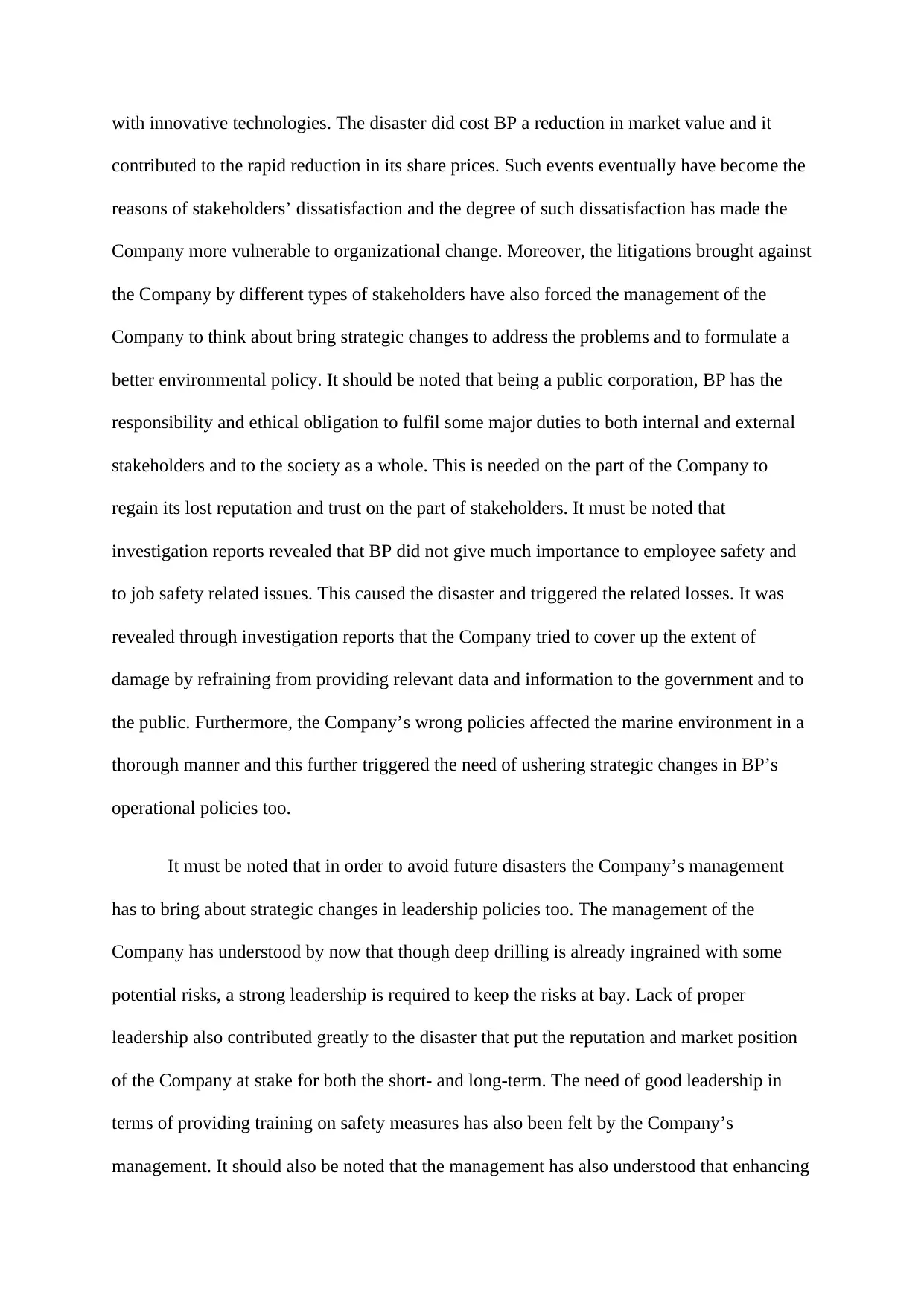
with innovative technologies. The disaster did cost BP a reduction in market value and it
contributed to the rapid reduction in its share prices. Such events eventually have become the
reasons of stakeholders’ dissatisfaction and the degree of such dissatisfaction has made the
Company more vulnerable to organizational change. Moreover, the litigations brought against
the Company by different types of stakeholders have also forced the management of the
Company to think about bring strategic changes to address the problems and to formulate a
better environmental policy. It should be noted that being a public corporation, BP has the
responsibility and ethical obligation to fulfil some major duties to both internal and external
stakeholders and to the society as a whole. This is needed on the part of the Company to
regain its lost reputation and trust on the part of stakeholders. It must be noted that
investigation reports revealed that BP did not give much importance to employee safety and
to job safety related issues. This caused the disaster and triggered the related losses. It was
revealed through investigation reports that the Company tried to cover up the extent of
damage by refraining from providing relevant data and information to the government and to
the public. Furthermore, the Company’s wrong policies affected the marine environment in a
thorough manner and this further triggered the need of ushering strategic changes in BP’s
operational policies too.
It must be noted that in order to avoid future disasters the Company’s management
has to bring about strategic changes in leadership policies too. The management of the
Company has understood by now that though deep drilling is already ingrained with some
potential risks, a strong leadership is required to keep the risks at bay. Lack of proper
leadership also contributed greatly to the disaster that put the reputation and market position
of the Company at stake for both the short- and long-term. The need of good leadership in
terms of providing training on safety measures has also been felt by the Company’s
management. It should also be noted that the management has also understood that enhancing
contributed to the rapid reduction in its share prices. Such events eventually have become the
reasons of stakeholders’ dissatisfaction and the degree of such dissatisfaction has made the
Company more vulnerable to organizational change. Moreover, the litigations brought against
the Company by different types of stakeholders have also forced the management of the
Company to think about bring strategic changes to address the problems and to formulate a
better environmental policy. It should be noted that being a public corporation, BP has the
responsibility and ethical obligation to fulfil some major duties to both internal and external
stakeholders and to the society as a whole. This is needed on the part of the Company to
regain its lost reputation and trust on the part of stakeholders. It must be noted that
investigation reports revealed that BP did not give much importance to employee safety and
to job safety related issues. This caused the disaster and triggered the related losses. It was
revealed through investigation reports that the Company tried to cover up the extent of
damage by refraining from providing relevant data and information to the government and to
the public. Furthermore, the Company’s wrong policies affected the marine environment in a
thorough manner and this further triggered the need of ushering strategic changes in BP’s
operational policies too.
It must be noted that in order to avoid future disasters the Company’s management
has to bring about strategic changes in leadership policies too. The management of the
Company has understood by now that though deep drilling is already ingrained with some
potential risks, a strong leadership is required to keep the risks at bay. Lack of proper
leadership also contributed greatly to the disaster that put the reputation and market position
of the Company at stake for both the short- and long-term. The need of good leadership in
terms of providing training on safety measures has also been felt by the Company’s
management. It should also be noted that the management has also understood that enhancing
⊘ This is a preview!⊘
Do you want full access?
Subscribe today to unlock all pages.

Trusted by 1+ million students worldwide
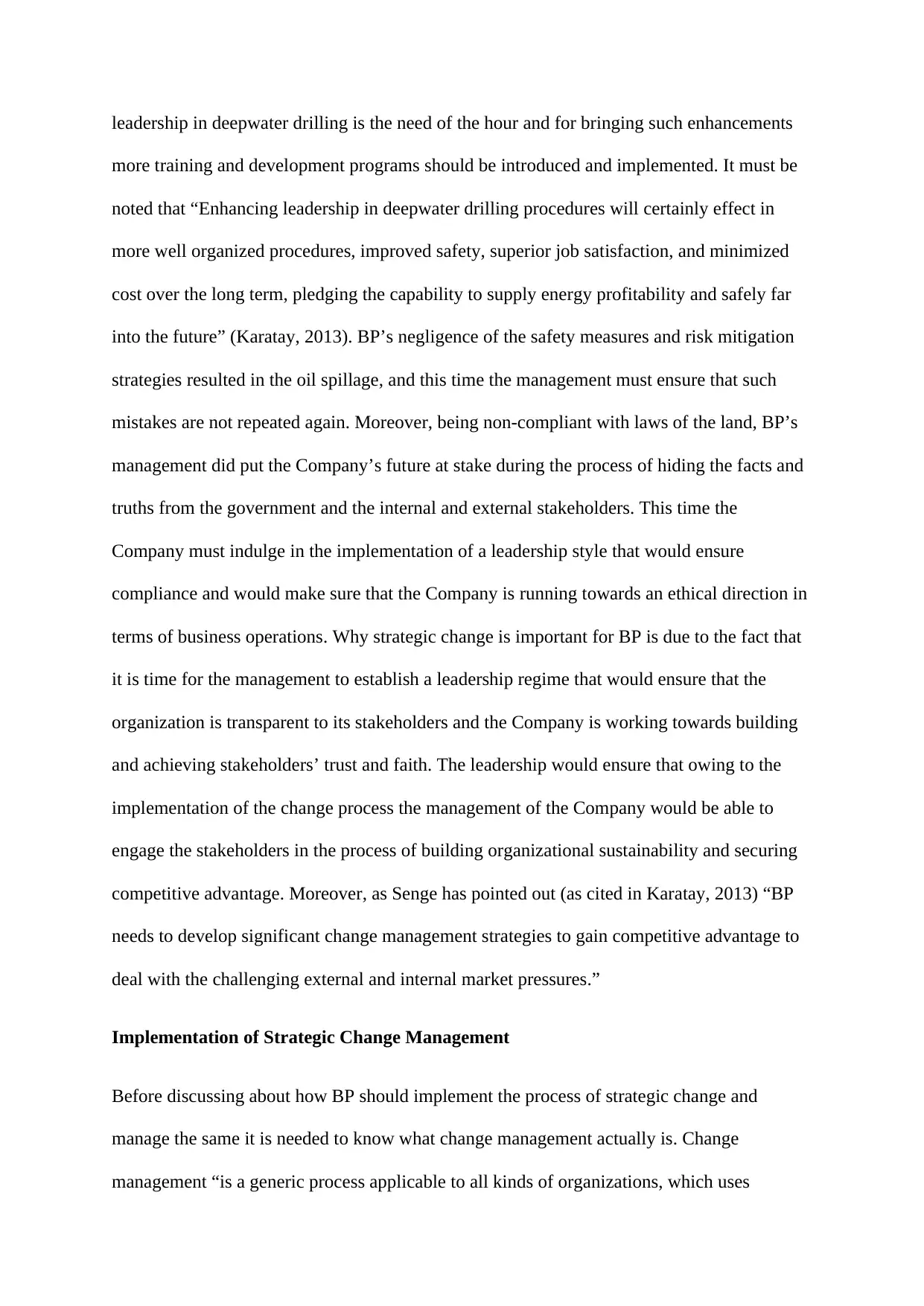
leadership in deepwater drilling is the need of the hour and for bringing such enhancements
more training and development programs should be introduced and implemented. It must be
noted that “Enhancing leadership in deepwater drilling procedures will certainly effect in
more well organized procedures, improved safety, superior job satisfaction, and minimized
cost over the long term, pledging the capability to supply energy profitability and safely far
into the future” (Karatay, 2013). BP’s negligence of the safety measures and risk mitigation
strategies resulted in the oil spillage, and this time the management must ensure that such
mistakes are not repeated again. Moreover, being non-compliant with laws of the land, BP’s
management did put the Company’s future at stake during the process of hiding the facts and
truths from the government and the internal and external stakeholders. This time the
Company must indulge in the implementation of a leadership style that would ensure
compliance and would make sure that the Company is running towards an ethical direction in
terms of business operations. Why strategic change is important for BP is due to the fact that
it is time for the management to establish a leadership regime that would ensure that the
organization is transparent to its stakeholders and the Company is working towards building
and achieving stakeholders’ trust and faith. The leadership would ensure that owing to the
implementation of the change process the management of the Company would be able to
engage the stakeholders in the process of building organizational sustainability and securing
competitive advantage. Moreover, as Senge has pointed out (as cited in Karatay, 2013) “BP
needs to develop significant change management strategies to gain competitive advantage to
deal with the challenging external and internal market pressures.”
Implementation of Strategic Change Management
Before discussing about how BP should implement the process of strategic change and
manage the same it is needed to know what change management actually is. Change
management “is a generic process applicable to all kinds of organizations, which uses
more training and development programs should be introduced and implemented. It must be
noted that “Enhancing leadership in deepwater drilling procedures will certainly effect in
more well organized procedures, improved safety, superior job satisfaction, and minimized
cost over the long term, pledging the capability to supply energy profitability and safely far
into the future” (Karatay, 2013). BP’s negligence of the safety measures and risk mitigation
strategies resulted in the oil spillage, and this time the management must ensure that such
mistakes are not repeated again. Moreover, being non-compliant with laws of the land, BP’s
management did put the Company’s future at stake during the process of hiding the facts and
truths from the government and the internal and external stakeholders. This time the
Company must indulge in the implementation of a leadership style that would ensure
compliance and would make sure that the Company is running towards an ethical direction in
terms of business operations. Why strategic change is important for BP is due to the fact that
it is time for the management to establish a leadership regime that would ensure that the
organization is transparent to its stakeholders and the Company is working towards building
and achieving stakeholders’ trust and faith. The leadership would ensure that owing to the
implementation of the change process the management of the Company would be able to
engage the stakeholders in the process of building organizational sustainability and securing
competitive advantage. Moreover, as Senge has pointed out (as cited in Karatay, 2013) “BP
needs to develop significant change management strategies to gain competitive advantage to
deal with the challenging external and internal market pressures.”
Implementation of Strategic Change Management
Before discussing about how BP should implement the process of strategic change and
manage the same it is needed to know what change management actually is. Change
management “is a generic process applicable to all kinds of organizations, which uses
Paraphrase This Document
Need a fresh take? Get an instant paraphrase of this document with our AI Paraphraser
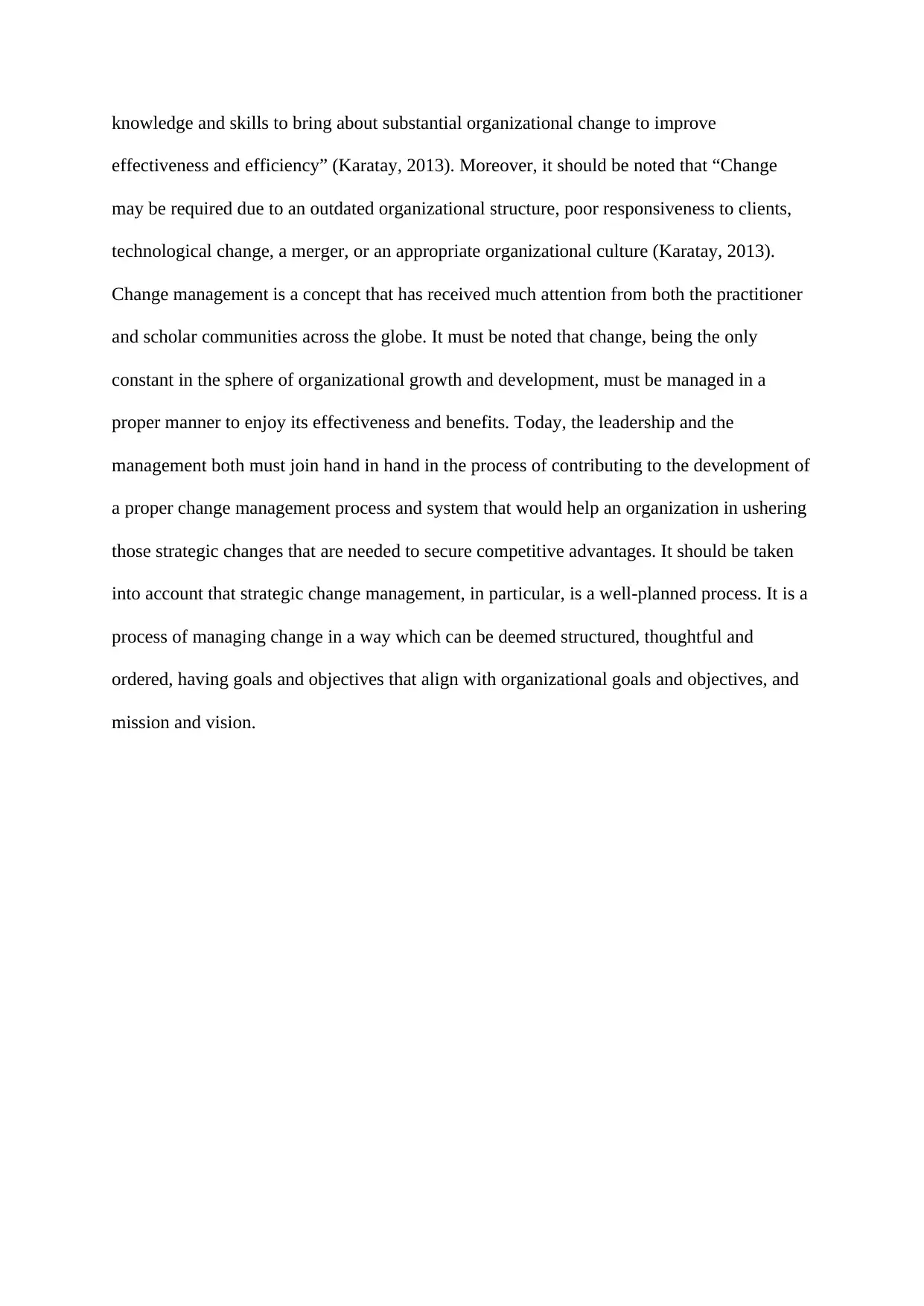
knowledge and skills to bring about substantial organizational change to improve
effectiveness and efficiency” (Karatay, 2013). Moreover, it should be noted that “Change
may be required due to an outdated organizational structure, poor responsiveness to clients,
technological change, a merger, or an appropriate organizational culture (Karatay, 2013).
Change management is a concept that has received much attention from both the practitioner
and scholar communities across the globe. It must be noted that change, being the only
constant in the sphere of organizational growth and development, must be managed in a
proper manner to enjoy its effectiveness and benefits. Today, the leadership and the
management both must join hand in hand in the process of contributing to the development of
a proper change management process and system that would help an organization in ushering
those strategic changes that are needed to secure competitive advantages. It should be taken
into account that strategic change management, in particular, is a well-planned process. It is a
process of managing change in a way which can be deemed structured, thoughtful and
ordered, having goals and objectives that align with organizational goals and objectives, and
mission and vision.
effectiveness and efficiency” (Karatay, 2013). Moreover, it should be noted that “Change
may be required due to an outdated organizational structure, poor responsiveness to clients,
technological change, a merger, or an appropriate organizational culture (Karatay, 2013).
Change management is a concept that has received much attention from both the practitioner
and scholar communities across the globe. It must be noted that change, being the only
constant in the sphere of organizational growth and development, must be managed in a
proper manner to enjoy its effectiveness and benefits. Today, the leadership and the
management both must join hand in hand in the process of contributing to the development of
a proper change management process and system that would help an organization in ushering
those strategic changes that are needed to secure competitive advantages. It should be taken
into account that strategic change management, in particular, is a well-planned process. It is a
process of managing change in a way which can be deemed structured, thoughtful and
ordered, having goals and objectives that align with organizational goals and objectives, and
mission and vision.
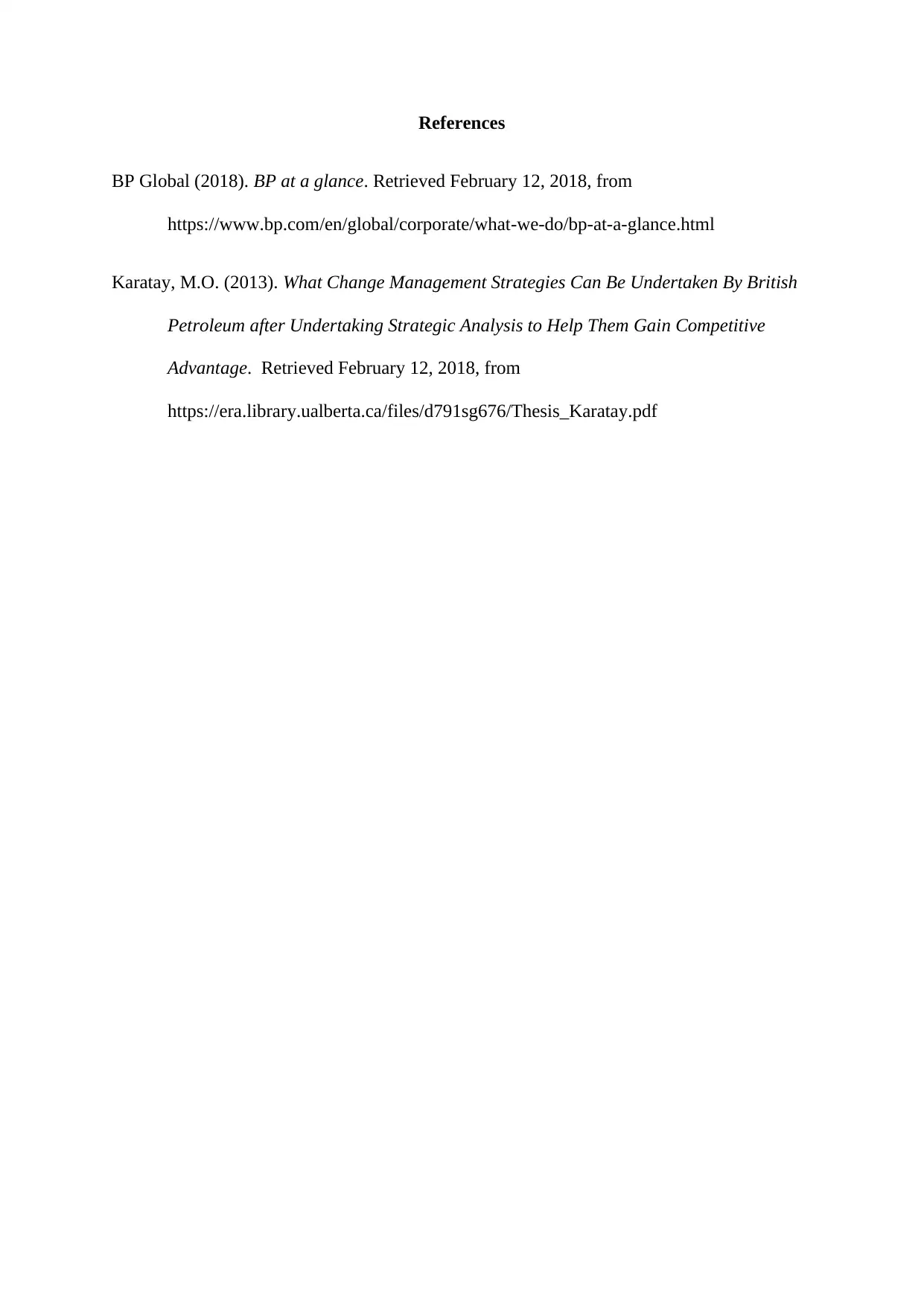
References
BP Global (2018). BP at a glance. Retrieved February 12, 2018, from
https://www.bp.com/en/global/corporate/what-we-do/bp-at-a-glance.html
Karatay, M.O. (2013). What Change Management Strategies Can Be Undertaken By British
Petroleum after Undertaking Strategic Analysis to Help Them Gain Competitive
Advantage. Retrieved February 12, 2018, from
https://era.library.ualberta.ca/files/d791sg676/Thesis_Karatay.pdf
BP Global (2018). BP at a glance. Retrieved February 12, 2018, from
https://www.bp.com/en/global/corporate/what-we-do/bp-at-a-glance.html
Karatay, M.O. (2013). What Change Management Strategies Can Be Undertaken By British
Petroleum after Undertaking Strategic Analysis to Help Them Gain Competitive
Advantage. Retrieved February 12, 2018, from
https://era.library.ualberta.ca/files/d791sg676/Thesis_Karatay.pdf
⊘ This is a preview!⊘
Do you want full access?
Subscribe today to unlock all pages.

Trusted by 1+ million students worldwide
1 out of 6
Related Documents
Your All-in-One AI-Powered Toolkit for Academic Success.
+13062052269
info@desklib.com
Available 24*7 on WhatsApp / Email
![[object Object]](/_next/static/media/star-bottom.7253800d.svg)
Unlock your academic potential
Copyright © 2020–2025 A2Z Services. All Rights Reserved. Developed and managed by ZUCOL.





